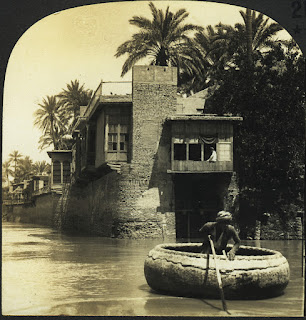This short video clip, filmed in 1948 in Arnhem Land, Northern Territory, Australia, shows a few of the steps of building a bark canoe and a bit of paddling what appears to be a different canoe at the conclusion of a successful sea turtle hunt.
What we observe of the canoe under construction:
We've written previously about canoes in Arnhem Land as they appear in the movie Ten Canoes. The construction method shown there appears to be the same, but the bow shape is different. In Ten Canoes, the craft have a ram bow or reverse overhang that may have been useful in parting the tall grass in the swamps where they were used. In contrast, the canoes in the present video were used at sea, where an overhanging bow would serve to ride up on waves and keep the interior dry, and a straight stem would at least not tend to shovel water into the boat.
Gunwale timbers similar to those shown in this video appear in other Australian bark canoes, like the one shown at the bottom of the image below. The shape of the bow in this example, however, is quite different from either of the boats shown in the present video.
Source: (Australia) National Film and Sound Archive
What we observe of the canoe under construction:
- The bark was stripped in a rectangular section, not the ovoid or lozenge-shaped sections as were used for the canoes of the Murray Valley and as seen in the image at the bottom of this post.
- The bark appears to be charred on the inside of the hull. This might have been done to make it more flexible, to harden it, or to drive out insects and/or moisture and prevent rot.
- The bark is folded roughly in half and held upright by stakes driven into the ground, which define the width of the hull.
- The ends are stitched closed with what we presume is vegetable fiber. The stitching is on an angle for a bit of bow or stern overhang. The bark is cut back to a line several inches outboard of the stitches after they are in place.
- A "thwart" is tapped into place to open the bark envelope to the desired width and keep it from closing up.
- There are gunwale timbers of round poles (seen briefly at 0:24) that stiffen the sides but do not extend to the ends of the boat. We assume they are stitched/tied to the top edges of the bark, but can't make out that detail.
- Abaft the thwart (assuming that we're looking toward the bow), a withy is tied between the opposite gunwales, apparently to keep the bark from opening too wide (which we assume could occur as it softens when wet).
- The ends are caulked with a liberal application of tree sap, probably mixed with some hardening agent like ash or charcoal.
We've written previously about canoes in Arnhem Land as they appear in the movie Ten Canoes. The construction method shown there appears to be the same, but the bow shape is different. In Ten Canoes, the craft have a ram bow or reverse overhang that may have been useful in parting the tall grass in the swamps where they were used. In contrast, the canoes in the present video were used at sea, where an overhanging bow would serve to ride up on waves and keep the interior dry, and a straight stem would at least not tend to shovel water into the boat.
Gunwale timbers similar to those shown in this video appear in other Australian bark canoes, like the one shown at the bottom of the image below. The shape of the bow in this example, however, is quite different from either of the boats shown in the present video.
 |
| Three types of Australian bark canoes. The one at top is the Murray Valley style, with the ends plugged with mud or clay. The ends of the canoe in the middle are bunched and tied. The canoe at the bottom has timber gunwales and a stitched end of complex shape. (Source: Edwin Doran, Jr., Wangka: Austronesian Canoe Origins) |













